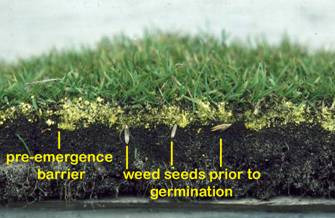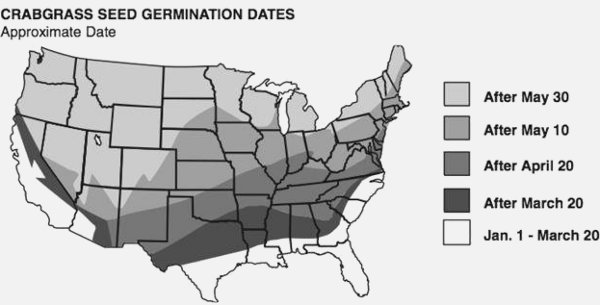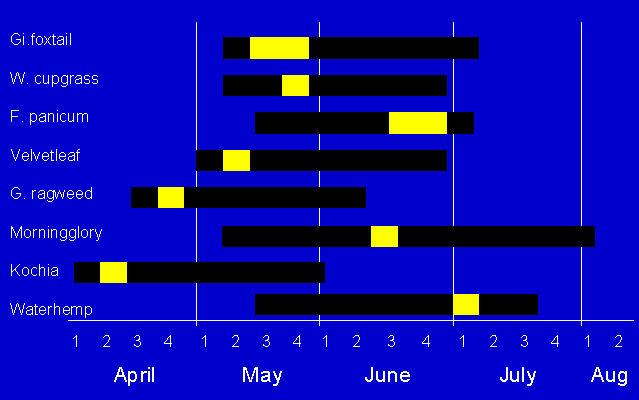7–10 minute read
A significant weed problem can be an indication that something is wrong. Thick, healthy turf or ground cover is the best defense against weeds. When thin, ask whether pH, drainage, sunlight level or tree root competition have made the area less suitable for the current planting. Weed control will be a constant battle if conditions cannot be corrected. Matching plant to site is the best way to reduce maintenance time and effort.
Management
It is essentially impossible to eliminate weeds. Moreover, weed seeds are reintroduced or exposed via wind, rain runoff, animals, contaminated soil/amendments, and gardening activities such as cultivation. Thus, effective weed management usually involves multiple methods:
Cultural
- choosing plants adapted to the site
- installing transplants rather than seeds
- optimizing plant health via appropriate spacing, watering, and fertilizing
- avoiding or containing potentially weedy plants
- sanitation
Biological
- insects, nematodes, bacteria, fungi or animals
- not usually applicable in a home setting
Mechanical
- selective exclusion
- mulching
- hoeing, cultivating, mowing, pruning
- less effective: hand-weeding, covering, solarizing
Chemical (herbicides)
- pre-emergent
- post-emergent
Weed identification
Knowing your enemy, especially whether the weed is annual vs. perennial, can make control decisions easier. This weed gallery shows many common southern weeds.
herbicides
If chemicals are part of your strategy, first decide on the level of control that you deem acceptable. Next, weigh the pros and cons of using a pre-emergent against those of a selective post-emergent. Consider likely efficacy, volatility (drift through air), leaching (groundwater contamination), and toxicity to non-target organisms. These vary by agent, but you will find specific information for the herbicides named in this article in the associated links. Many gardeners use both a pre-emergent herbicide and post-emergent control of some type.
Pre-emergent
Proper application, timing, and product selection are critical for achieving the greatest benefit.
Application: Create a good barrier
 Photo by Bob Mugass, U of MN SULIS
Photo by Bob Mugass, U of MN SULIS
Pre-emergents do not prevent weed germination. Instead, weed growth is disrupted as a seedling grows through the pre-emergent barrier. For control to be effective, the barrier zone must be present and intact prior to weed germination.
- To create a good initial barrier, apply granules or liquid evenly at the label rate. Calibrate your spreader first, then apply one half of the product along one axis and the second half at right angles.
- It is critical to water according to the product instructions because the product needs to penetrate into the soil in order to work. Don’t delay watering, because most products will degrade within days if exposed to sunlight or heat. In addition, birds can mistake granules for grit or seed. Prompt watering-in will minimize this risk.
Timing

While the map is a rough guide, consistency is not a feature of our weather. Last year, crabgrass and Japanese stiltgrass germinated 30 days earlier than usual. Rather than using an inflexible calendar date for initial application, try some alternatives:
- Soil temperature is a primary germination cue for many summer annual weeds and is widely used to determine the best time for pre-emergent application. You can buy an inexpensive soil min-max thermometer, but an accurate reading requires positioning at just the right depth and moisture level. An easier way is to check the daily soil temperature average using the Durham ECONET observations.
- First, pick retrieval time of 90 days.
- Scroll to Daily Soil Parameters and select Soil temperature daily average.
- Scroll to buttons and select Retrieve data.
- For crabgrass, try to apply pre-emergent when the daily average reaches 50°F for three consecutive days. This is the recommended timing to catch initial germination, which occurs roughly when the daily average reaches 55°F for three consecutive days.
- Phenology. The classic advice for crabgrass is to apply pre-emergent when the forsythia is in bloom. Another approach is to monitor for seedlings in hot areas where weed seeds tend to lodge, such as the edges of walks, patios, and driveways. You may miss control in these spots and sunny areas like southern slopes but still reduce growth in much of the yard.
Number of applications
Weed species do not germinate simultaneously and even within a species, germination can occur over a long time frame. For instance, crabgrass begins to germinate when the minimum 24-hour mean soil temperature (four inch depth) is 55°F, but most crabgrass germinates at soil temperatures of 60–70°F. Additional variables like microclimate and seed depth can result in germination through much of the growing season. This is typical of many weed species, as illustrated in the study below.
 Weed emergence research The yellow portion of the bar is the period of maximum emergence for the individual species.
Weed emergence research The yellow portion of the bar is the period of maximum emergence for the individual species.
The practical consequence of prolonged weed emergence is that control likely will require more than a single pre-emergent application. Mark the initial application date on your calendar and refer to the product label for the minimum time between applications.
In addition, plan to use pre-emergent for at least several years. Control should continue until the seed bank is exhausted, and the seeds of species targeted by pre-emergents typically have life spans of 3–5 years.
Choosing a pre-emergent
In general, pre-emergents target grassy annual weeds, but some products are active against broadleaf weeds and a few have post-emergent activity. Here are some special circumstances where product choice is important:
- When seeding a lawn Siduron is the only pre-emergent that is labeled for use during seeding of a new lawn. It has a short duration of action, so it must be re-applied every 3–4 weeks. Alternatively, use it once or twice and then deploy a longer-acting agent.
- Immature lawn Mesotrione can be applied as early as 28 days after seeding and controls crabgrass as well as many broadleaf weeds both pre- and post-emergence. Dithiopyr is primarily a pre-emergent, but is effective early post-emergence on annual grasses like crabgrass. This is considered to be the safest of the typical pre-emergents (these target cell division) and normally can be used after the second mowing. Note that dithiopyr is volatile and can potentially injure non-target plants if not properly applied and watered in, while mesotrione readily leaches in soils low in organic matter and has the potential to contaminate groundwater.
- Broadleaf weeds Isoxaben is labeled for pre-emergent broadleaf weed control in established turf, ornamental beds, groundcovers, nursery stock, ornamental bulbs, and non-bearing fruit trees.
- Season-long control is not likely here due to our long growing season, but prodiamine and dithiopyr are long-acting. While some long-acting products can to leach into groundwater, leaching is negligible for prodiamine and dithiopyr. However, both prodiamine and dithiopyr are volatile and have the potential to injure non-target plants if not properly applied and watered in.
- Vegetables and fruits While there are pre-emergents labeled for use on particular crops, appropriate crop rotation, spacing, mulching, and cultivation are the safest approach to weed control. Corn gluten meal is often touted as a safe and effective pre-emergent, but subsequent studies have not been able to replicate the efficacy of corn gluten meal observed in initial studies.
Resources
Preemergence Herbicides for Herbaceous Ornamentals
Post-emergent
Post-emergent herbicides can be either contact or systemic.
- Contact herbicides kill only the treated plant tissue. Damage is rapidly visible but because the root system is not affected, these herbicides usually kill only young annual weeds.
- Systemic herbicides act more slowly because they must be absorbed and translocated within the plant before acting. Chosen and applied correctly, systemics are effective for even tough perennial weeds. It is important to be patient — cutting back a weed or damaging its foliage during the translocation phase will reduce the effectiveness of the systemic.
Application
In general, the best conditions for application are when temperatures are between 65°–85°F on a sunny day. This maximizes plant absorption and minimizes herbicide volatilization. Check the label for specific recommendations. Plant factors are also critically important. Many conditions reduce absorption or translocation:
- plant stress (drought, cold)
- plant stage (Actively growing plants are most susceptible, plants beginning to seed are usually resistant. Weedy grasses are most susceptible when less than 6 inches tall.)
- plant trimmed or mowed within a few days before or after application
Apply the herbicide until just before spray runs off the plant, being careful to avoid contact with desirable plants if the product is non-selective. Keep in mind that heavy use of a single herbicide active ingredient or mode of action places heavy selection pressure on a weed population and may eventually select for resistant individuals.
Resources
- Weed Susceptibilities to Postemergence Herbicides
- Non-selective post-emergence herbicides
- Controlling Invasive Plants
Resources
